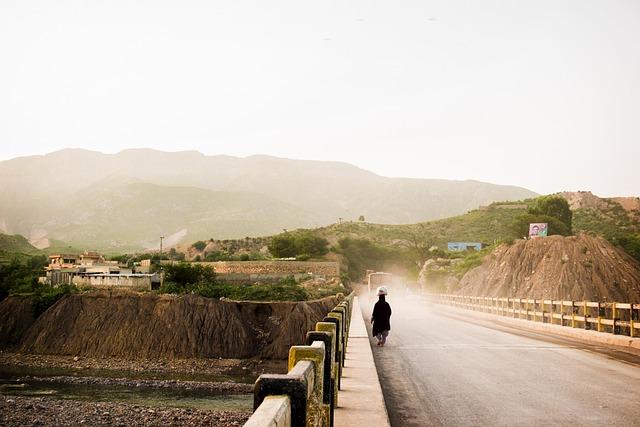In the heart of South Asia lies Pakistan, a nation marked by breathtaking landscapes and a rich tapestry of culture and history. Yet, overshadowing its beauty are the lingering scars of terrorism that have tested the spirit and tenacity of its people. Over the past two decades, Pakistan has faced profound challenges, battling extremist ideologies that have sought to destabilize its society and governance. This article delves into the multifaceted journey of resilience that Pakistan has undertaken—a journey characterized not just by strife and adversities, but by hope, recovery, and an unwavering commitment to emerge stronger. As the nation confronts the shadows of terrorism, it reveals a narrative of bravery and renewal that may serve as an inspiring lesson for others navigating their own tumultuous paths. Join us as we explore Pakistan’s battle against the tide of extremism and its steadfast resolve to forge a brighter, more secure future.
Understanding the Evolution of Terrorism in Pakistan
The narrative of terrorism in Pakistan has been shaped by a myriad of factors, evolving through distinct phases since the late 20th century. Initially, the rise of militant groups was fueled by geopolitical dynamics, particularly the Soviet-Afghan War, which saw the emergence of a mujahideen ethos that was later exploited by various factions within Pakistan. Over time, these groups morphed into organized networks, each with their own ideologies and methods, leading to an escalation of violence that engulfed not only government officials but also civilians in their quest for political and ideological objectives. The complex tapestry of ethnic tensions, religious radicalization, and foreign intervention further exacerbated the situation, creating a fertile ground for terrorist ideologies to take root.
As Pakistan navigated through these challenges, it became evident that understanding this phenomenon required a multi-faceted approach. The government’s response has oscillated between military operations and community engagement, recognizing that mere force would not dismantle the deeply ingrained networks of extremism. Today, efforts are being made to counter radicalization through education and rehabilitation programs, aiming to address the root causes rather than just the symptoms. Key strategies now include:
- Counter-terrorism operations: Robust military strategies to dismantle terrorist strongholds.
- Community awareness: Engaging local communities to foster resilience against extremist narratives.
- International partnerships: Collaborating with global allies to share intelligence and resources.
Table: Key Phases of Terrorism in Pakistan
| Phase | Characteristics | Impact |
|---|---|---|
| 1980s | Rise of Mujahideen | Emergence of radical ideologies |
| 1990s | Militant group formation | Increased violence and sectarian strife |
| 2000s | Global jihadist networks | Heightened domestic terrorism |
| 2010s | Balancing military action and dialogue | Strides in counter-terrorism policy |

Community Engagement: A Pillar of Resilience Against Extremism
At the heart of any effective approach to countering extremism lies the profound and active involvement of local communities. Engaging communities fosters a sense of belonging and resilience, which serves as a formidable defense against the allure of radical ideologies. By promoting dialogue and facilitating partnerships between various societal sectors, such as education, religious institutions, and local governments, Pakistan can create an inclusive environment where individuals feel seen and heard. Community initiatives can play a critical role in this transformation, including:
- Workshops and Training: Equipping community leaders and youth with the skills to challenge extremist narratives.
- Cultural Events: Celebrating local heritage to reinforce shared identity and values.
- Support Networks: Establishing groups to provide emotional and psychological support to at-risk individuals.
Moreover, it is essential to utilize technology and social media platforms for community engagement. These tools can amplify positive voices, counter misinformation, and facilitate connections across diverse demographics. Empowering citizens to take part in campaigns against extremism not only educates them about the realities of radicalization but also inspires a grassroots movement dedicated to peace and unity. Through community-driven efforts, the following approaches can further solidify this foundation:
| Strategy | Objective |
|---|---|
| Community Policing | Building trust between law enforcement and residents to enhance safety. |
| Youth Engagement Programs | Providing positive outlets for young people to express themselves. |
| Interfaith Dialogues | Promoting understanding and cooperation among different religious groups. |

Strengthening Law Enforcement: Building Trust and Capability
In the relentless battle against terrorism, fostering a strong relationship between law enforcement agencies and the communities they serve is crucial. Building this trust requires a multi-faceted approach where transparency, accountability, and community engagement are at the forefront. Initiatives that promote open communication, such as community policing programs and regular town hall meetings, can significantly enhance public confidence in law enforcement. When communities see themselves as partners in crime prevention, the flow of critical information increases, allowing officers to act swiftly against emerging threats.
Beyond trust, the capability of law enforcement must be continually enhanced to adapt to the evolving tactics of terrorist organizations. Investing in advanced training programs and state-of-the-art technology can empower police and security forces to respond more effectively in crisis situations. Resources should be allocated to ensure that personnel are equipped not only with the tools they need but also with the critical skills to analyze and respond to potential threats. This includes:
- Specialized Counter-Terrorism Units: Forming elite teams dedicated to addressing specific threats.
- Intelligence Sharing: Establishing robust networks for sharing information across agencies.
- Cybersecurity Training: Equipping officers with skills to combat online radicalization.
As Pakistan strives to confront its challenges, the importance of a resilient and capable law enforcement framework cannot be overstated. It’s not just about tackling the immediate threats, but about creating an environment where all citizens feel safe and supported. To visualize the ongoing efforts, here’s an overview of some recent statistics highlighting the progress in law enforcement capabilities:
| Year | Training Programs Implemented | Community Engagement Events | Reduction in Violent Incidents |
|---|---|---|---|
| 2021 | 12 | 45 | 15% |
| 2022 | 18 | 60 | 20% |
| 2023 | 25 | 75 | 25% |

Pathways to Peace: Promoting Dialogue and Sustainable Solutions
In the complex landscape of Pakistan, dialogue and collaboration emerge as essential pillars in the pursuit of peace. The country has faced decades of violence and turmoil, often born from deep-seated grievances and mistrust among various communities. To counter these challenges, it is imperative to forge open channels of communication both within the nation and across its borders. This dialogue must encompass not only governmental discussions but also grassroots efforts involving civil society, educational institutions, and marginalized groups. By fostering understanding and empathy through community forums, cultural exchanges, and educational programs, Pakistan can build a framework where differences become a source of strength rather than division.
Moreover, sustainable solutions require addressing the root causes of terrorism through holistic development initiatives. Key strategies may include:
- Enhancing economic opportunities, particularly in underprivileged regions.
- Investing in education and vocational training to empower youth.
- Strengthening law enforcement and judicial systems to ensure justice and security.
- Promoting mental health resources and rehabilitation programs for affected individuals.
To support these efforts, a multi-stakeholder approach that includes international partnerships can be invaluable. The following table outlines potential collaborative initiatives:
| Initiative | Description | Expected Outcome |
|---|---|---|
| Community Dialogues | Facilitated discussions among diverse groups | Increased understanding and trust |
| Economic Development Programs | Job creation in high-risk areas | Reduction in poverty and instability |
| Education Partnerships | Collaboration with NGOs for schooling | Empowerment through knowledge |
Insights and Conclusions
As the sun sets over the rugged landscapes of Pakistan, it casts long shadows that speak of resilience and hope. The journey through the challenges posed by terrorism is a testament to the unwavering spirit of a nation that refuses to be defined by fear. While the scars of the past may linger, they also serve as a reminder of the strength found in unity and the determination to rise above adversity.
In navigating the complexities of this ongoing battle, Pakistan is not merely confronting threats; it is also building a future rooted in peace, tolerance, and progress. Each community restored, each dialogue fostered, and each act of compassion reinforces the idea that the fight against terrorism is not just a defense of borders, but a deep commitment to humanity itself.
The path ahead may be fraught with challenges, yet the resilience of the Pakistani people shines brightly, illuminating the possibility of a tomorrow free from the shadows of violence. As the nation continues to confront these issues, it stands as a powerful reminder that hope, courage, and perseverance can triumph even in the darkest of times. The story of Pakistan is one of survival against all odds, and it is a narrative that deserves to be told, understood, and celebrated.



